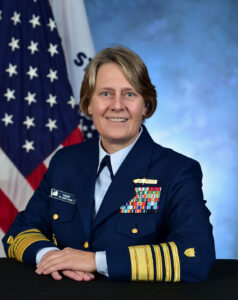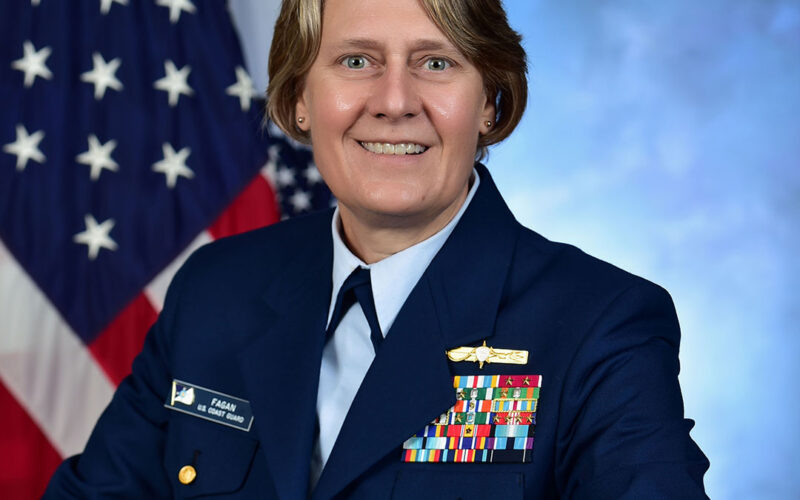
Adm. Linda Fagan, commandant of the U.S. Coast Guard, recently delivered her first State of the Coast Guard Address at the Reserve Organization of America.
“It is an exciting time for the Coast Guard and our workforce,” she said. “For nearly 233 years our service has provided safety and security for the American people. Today we uphold that tradition and the Coast Guard’s future is bright.”
The Coast Guard “has never been in greater demand around the world, and that demand is matched by greater recognition of the service’s value to the nation. There are challenges ahead but with the dedication, professionalism, and passion of everyone who serves in the Coast Guard, we are ready to meet them all.”
Calling the Service “a unique instrument of national power,” she described the Coast Guard as “a military service, a law enforcement agency and a regulatory agency. Our combination of authorities and capabilities means we contribute to America’s national security and economic prosperity in ways no other single federal entity can.”
As an operational component within the Department of Homeland Security, the Coast Guard “is committed to the secretary’s priorities, including maritime border security, crisis response leadership, and cybersecurity protection of critical infrastructure,” she added.
“We have the enduring responsibility to safeguard the Marine Transportation System and enable the uninterrupted flow of commerce, which sustains more than 30 million American jobs and contributes more than $5.4 trillion to the U.S. economy every year. More than 90 percent of the nation’s imports and exports move by water,” said Fagan.
“Just as important as our major ports, are the 14,000 miles of waterways on our inland rivers that power the economic engine of the heartland,” she stated. “The importance of river transportation was made clear this past fall. Extreme low water levels on the Mississippi River restricted vessel traffic, making it difficult for Midwestern farmers to get their harvest to market.”
The Coast Guard’s inland river cutter fleet, she stated, “has worked feverishly to reset the buoys marking the shifting channels. Some of these cutters have been serving since World War II. I am excited about the new waterways commerce cutter, which will give our crews reliable platforms to do their economically vital work on the rivers. The new cutters will also accommodate both men and women, ensuring heartland assignments are open to every member of the service.”
The rivers, said Fagan, “are not our nation’s only critical freshwater transportation links. On the Great Lakes, the shipping industry moves more than 160 million tons of cargo every year. That flow must continue even during the harsh winter ice season. Your Coast Guard facilitates nearly 1,000 vessel transits every winter with our fleet of seven icebreakers in the region. I am fully committed to fielding critical Great Lakes icebreaking capability to keep that traffic moving.”
Farther offshore, new technology is increasing demand for Coast Guard waterways management, she commented. “The offshore wind industry will soon begin constructing wind turbines in an area of ocean larger than the state of Rhode Island. Our offshore waters are equally important to the growing commercial space industry. American companies launched more than 2,000 spacecraft last year, a 36 percent increase from the year before.”
According to Fagan, “the Marine Transportation System is a complex network of infrastructure, vessels, sensors, and data that enables the efficient movement of cargo and passengers. These essential networks are vulnerable to malign cyber activity. The Coast Guard’s responsibility to maintain a safe and secure Marine Transportation System extends to cyberspace, our newest operational domain.”
The nation, she said, “now has two fully operational cyber protection teams. They work proactively with government and industry partners to protect our ports from cyber threats. I’m pleased to share that a new cyber protection team will soon stand up on the West Coast. To staff our growing cyber protection capability, this year we will assign the first members of the new cyber mission specialist rating in our enlisted workforce. These professionals will enhance the Coast Guard’s capacity to protect the maritime industry in cyberspace.”
Data, she said, “is a strategic asset. We recently stood up a new Office of Data and Analytics. This expert team is accelerating the implementation of a new ‘big data’ platform we call Surveyor. This system will integrate enterprise-level data and workforce analytics to enable better decision making.”
The Coast Guard “will keep pace with changes impacting the Marine Transportation System as we conduct our missions on our coastlines, rivers, lakes, and maritime borders. But we are aware of looming threats that could challenge our ability to succeed in the future. We must apply foresight and take action today to be ready for tomorrow,” she added.
“Like the other branches of the armed forces, and much of private sector, the Coast Guard is experiencing a workforce shortage,” stated Fagan. “We are struggling to recruit the people we need to hire into our ranks. Our recruiting shortfall threatens our readiness and ability to serve the American people. I have a sense of urgency to address this challenge. We must ensure that every American, from coast to coast and throughout the inland states, knows who we are and what we do.”
Expressing gratitude for the $6.5 million above the Service’s original budget request that Congress provided to increase our recruiting capacity, she stated that, “We are opening seven new recruiting offices, to be present in more American communities. And we are standing up four new Junior ROTC units this year, bringing the Coast Guard’s total to 10 across the nation. This is a large expansion of a very exciting program.”
“We are a global Coast Guard. This is our value to the nation. We may be small, but we are incredibly capable,” said Fagan. “Everywhere the United States has maritime interests, we protect, we defend, we save. We are the United States Coast Guard. Every day, our crews do difficult work. They brave wind and waves to complete their missions. We will apply that same determination to confront the challenges we face as a Service and will emerge even stronger sentinels of our maritime safety, maritime security, and economic prosperity.”
Admiral Fagan assumed the duties as the 27th Commandant of the United States Coast Guard on June 1, 2022. As Commandant, she oversees all global Coast Guard operations and 42,000 active-duty, 7,000 reserve, and 8,700 civilian personnel, as well as the support of 21,000 Coast Guard Auxiliary volunteers.
Previously, she served as the 32nd Vice Commandant. Prior flag assignments include Commander, Pacific Area, and Commander, Coast Guard Defense Force West; Deputy Commandant for Operations, Policy, and Capability; Commander, First Coast Guard District; and a joint assignment as Deputy Director of Operations for Headquarters, United States Northern Command.

